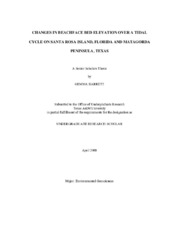| dc.description.abstract | Wave-scale changes in beach elevation were measured using a cross-shore array of
ultrasonic distance sensors on a dissipative beach at Matagorda Peninsula, Texas, in
December 2008. The data collected in this study are compared to data collected in a
companion study on an intermediate beach in Pensacola, Florida in June 2008. Both
beaches are currently in a state of recovery from hurricane activity within the last 5
years, and therefore serve as good comparison sites for bed elevation change models. At
both sites, the ultrasonic distance sensors were used to measure the bed elevation
changes to 0.08 m which is smaller than the median grain size at both study sites (0.2
mm and 0.3 mm respectively). The dissipative Matagorda site was found to be less
affected by swash over the study period and maintained a steady state bed elevation with
max change of .01 m. In comparison, the intermediate, Pensacola site was more affected
by the swash and varied by 0.14 m in its bed elevation over a tidal cycle. It is argued that
iv
intermediate beaches are more affected by individual swash, while dissipative beaches
are more affected overtime by the migration of bedforms rather than individual swash. | en |


